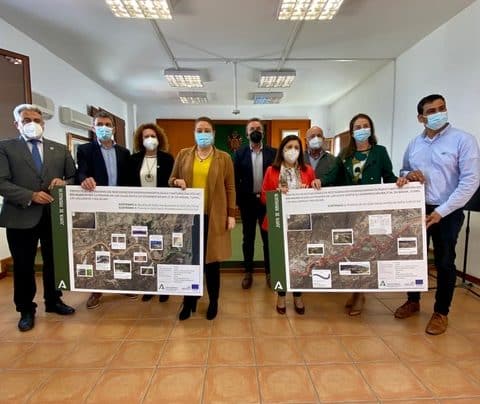- Almost 54,000 people will benefit from the new treatment plant to be built by the Regional Government in Mojácar
The Minister of Sustainable Development has signed the agreement with the Mayors of Mojácar, Bédar, Los Gallardos, Garrucha and Turre to implement the work.
Carmen Crespo announced an April start for the extensive environmental restoration project on 21.4 kms of the Río Aguas.
On 26th March, the Regional Minister for Agriculture, Livestock, Fisheries and Sustainable Development, Carmen Crespo, signed the construction agreement for a new wastewater treatment plant in Mojácar that will benefit its own residents as well as those living in Bédar, Los Gallardos, Garrucha and Turre. The project, which is already at the bidding stage after going out to tender, represents a “historical investment of 23.9 million Euros,” the Minister pointed out.
The new infrastructure, as part of the EDAR group of waste plants, will make possible the replacement of obsolete facilities, which are now 25 years old. The waste treatments will then be appropriate for the increased population, which has also grown by the area’s tourism over the years. The General Director for Water Infrastructures, Sergio Arjona, added that the design for construction had considered a population of 53,800 inhabitants to service.
The new Andalucían Government has now given a “an about turn to the water policy” placing it at the top of their agenda, whilst also “promoting collaboration between administrations, mainly local organisations, to advance water purification systems and put an end to the discharges in our rivers and seas.”
Finally, Carmen Crespo thanked the collaborators involved, adding how much citizens are keen to see the various administrations working together on the development of projects.
Additionally, she also announced an April start-up in Mojácar for the environmental regeneration project for riverbeds that has been carried out in the province of Almería over recent years, as well as those that have been carried out as emergencies following times of severe climate change. This project will cover 21.4 kms of the Rio Aguas with an investment of 6 million Euros, taking in the area from the hamlet of Giles, to the mouth of the Mediterranean and the Mojaquero beaches.
The project presentation, involving the General Director of Planning and Water Resources, Fernando Delgado, clarified that some works will be carried out within a period of two years, affecting the municipal areas of Los Gallardos, Turre and Mojácar. Waste will be removed from the riverbed, invasive elements removed, along with the planting of more than 51,000 native plants of 20 different species.
Environmental restoration
“To the project’s great magnitude must be highlighted its extraordinary environmental value, since this river feeds two areas of special protection of the Natura 2000 Network, the Kart de Yesos, the Sierra Cabrera-Bédar and at its mouth, the Laguna de Mojácar Lagoon, all of great natural interest,” added the Minister. In such sensitive spaces, the project work’s reports have necessitated “extreme care” that the Río Aguas restoration is in line with the conservation strategy for this type of protected natural space.
She went on to say, “this restoration of one of the five most important rivers in the province of Almería combines the safety of the area against floods, the protection of agricultural lands located on the banks of the river and, the preservation of the environment and its biodiversity.” She also emphasized that “in any landscape, which may appear unfavourable to life or growth, there is often a wealth of life that we have to protect.”
Mojácar’s Mayor, Rosa María Cano, went on to thank “the Juanma Moreno Government team for their response to a demand that had been made continually over the last fourteen years” and, finally the replacement of the current obsolete installation will meet an “obligation to meet the needs of the people.” She also expressed her “immense satisfaction” that the restoration project would correct what had been a cause of great concern, through the “misuse given at times” to the river, as well as by the dangerous periods of heavy rain.





